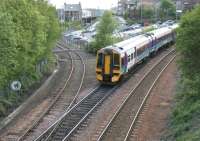Jamestown Viaduct
Jamestown Viaduct strengthening: Between the town of Inverkeithing in Fife and the Forth Bridge lies Jamestown Viaduct. Built in the 1880s, this 115-year old listed structure was subject to a major upgrading in mid 1995 in order to enable it to cope with the increasing loads and traffic volumes on this heavily used route.
The Network Rail design brief for the project required that the external appearance remain largely unaltered on completion and that critical work be carried out in parallel with the scheduled 8-day closure of the Forth Bridge.
An innovative design approach to the project was developed by Corus, working closely with Mowlem, Network Rail and Historic Scotland.
For the benefit of the technically minded this involved the introduction of a reinforced concrete slab to act compositely with existing trusses and cross girders. To achieve this, steel diaphragm panels were installed in the apertures between the cross girders to transfer shear between the slab and the tops of the trusses. Trials were carried out in advance to verify the feasibility of welding the 19th century deck plates to function as permanent formwork for the slab. The connection between the new deck slab and the structure was provided via 8,600 stud connectors.
With the necessary strengthening work completed successfully the viaduct is now able to cope with 27 million tonnes of rail traffic per annum ? thus granting the historic structure a new lease of life.
The following images show various views of Jamestown Viaduct.
JF June 2006.
Addendum from 'The Scotsman' 7 July 2006
Forth bridges building on success.
WORK on a rail viaduct near the Forth Bridge and a new bridge in Montrose have been shortlisted for this year's Prime Minister's Better Public Building Award.
The Jamestown viaduct, at Inverkeithing in Fife, which is used by 200 trains a day, was strengthened during an eight-day closure last summer.
The judges said the ?4 million project 'showed civil engineering delivery of a high-standard where extremely tight deadlines prompted a highly disciplined team response'.
John Furnevel














![<h4><a href='/locations/J/Jamestown_Viaduct_Inverkeithing'>Jamestown Viaduct [Inverkeithing]</a></h4><p><small><a href='/companies/F/Forth_Bridge_Railway'>Forth Bridge Railway</a></small></p><p>Sprinter crossing the Jamestown Viaduct. 1/14</p><p>//<br><small><a href='/contributors/Ewan_Crawford'>Ewan Crawford</a></small></p>](/__cache/thumbnails/3000/3387.jpg)
![<h4><a href='/locations/J/Jamestown_Viaduct_Inverkeithing'>Jamestown Viaduct [Inverkeithing]</a></h4><p><small><a href='/companies/F/Forth_Bridge_Railway'>Forth Bridge Railway</a></small></p><p>Heading south from the Jamestown Viaduct towards the Forth Bridge. 2/14</p><p>//<br><small><a href='/contributors/Ewan_Crawford'>Ewan Crawford</a></small></p>](/__cache/thumbnails/7000/7535.jpg)
![<h4><a href='/locations/J/Jamestown_Viaduct_Inverkeithing'>Jamestown Viaduct [Inverkeithing]</a></h4><p><small><a href='/companies/F/Forth_Bridge_Railway'>Forth Bridge Railway</a></small></p><p>A DMU crossing Jamestown Viaduct in March 1971. View north towards Inverkeithing. 3/14</p><p>23/03/1971<br><small><a href='/contributors/John_Furnevel'>John Furnevel</a></small></p>](/__cache/thumbnails/3000/3449.jpg)

![<h4><a href='/locations/J/Jamestown_Viaduct_Inverkeithing'>Jamestown Viaduct [Inverkeithing]</a></h4><p><small><a href='/companies/F/Forth_Bridge_Railway'>Forth Bridge Railway</a></small></p><p>Northbound coal empties on the approach to Jamestown Viaduct in June 2006 with the Zeebrugge Ferry docking at Rosyth in the background. 5/14</p><p>/06/2006<br><small><a href='/contributors/John_Furnevel'>John Furnevel</a></small></p>](/__cache/thumbnails/9000/9754.jpg)
![<h4><a href='/locations/J/Jamestown_Viaduct_Inverkeithing'>Jamestown Viaduct [Inverkeithing]</a></h4><p><small><a href='/companies/F/Forth_Bridge_Railway'>Forth Bridge Railway</a></small></p><p>The deep rock cutting between the Forth Bridge and Jamestown Viaduct in 2006 looking south. 6/14</p><p>/06/2006<br><small><a href='/contributors/John_Furnevel'>John Furnevel</a></small></p>](/__cache/thumbnails/9000/9755.jpg)
![<h4><a href='/locations/J/Jamestown_Viaduct_Inverkeithing'>Jamestown Viaduct [Inverkeithing]</a></h4><p><small><a href='/companies/F/Forth_Bridge_Railway'>Forth Bridge Railway</a></small></p><p>Train for Edinburgh Waverley on Jamestown Viaduct on a sunny day in June 2006. On the left is the M90 motorway and Ferry Toll Park and Ride can be seen through the viaduct. 7/14</p><p>/06/2006<br><small><a href='/contributors/John_Furnevel'>John Furnevel</a></small></p>](/__cache/thumbnails/9000/9757.jpg)
![<h4><a href='/locations/J/Jamestown_Viaduct_Inverkeithing'>Jamestown Viaduct [Inverkeithing]</a></h4><p><small><a href='/companies/F/Forth_Bridge_Railway'>Forth Bridge Railway</a></small></p><p>Longannet - Hunterston empties crossing Jamestown Viaduct in June 2006. 8/14</p><p>20/06/2006<br><small><a href='/contributors/John_Furnevel'>John Furnevel</a></small></p>](/__cache/thumbnails/9000/9751.jpg)
![<h4><a href='/locations/J/Jamestown_Viaduct_Inverkeithing'>Jamestown Viaduct [Inverkeithing]</a></h4><p><small><a href='/companies/F/Forth_Bridge_Railway'>Forth Bridge Railway</a></small></p><p>A northbound train running onto Jamestown Viaduct heading for Inverkeithing on 20 June 2006. 9/14</p><p>20/06/2006<br><small><a href='/contributors/John_Furnevel'>John Furnevel</a></small></p>](/__cache/thumbnails/9000/9752.jpg)
![<h4><a href='/locations/J/Jamestown_Viaduct_Inverkeithing'>Jamestown Viaduct [Inverkeithing]</a></h4><p><small><a href='/companies/F/Forth_Bridge_Railway'>Forth Bridge Railway</a></small></p><p>Looking southwest as a Fife Circle train crosses Jamestown Viaduct in June 2006. 10/14</p><p>20/06/2006<br><small><a href='/contributors/John_Furnevel'>John Furnevel</a></small></p>](/__cache/thumbnails/9000/9753.jpg)
![<h4><a href='/locations/J/Jamestown_Viaduct_Inverkeithing'>Jamestown Viaduct [Inverkeithing]</a></h4><p><small><a href='/companies/F/Forth_Bridge_Railway'>Forth Bridge Railway</a></small></p><p>Jamestown Viaduct in 2006 looking towards Inverkeithing. Below is the line running down from Inverkeithing South Junction, under the viaduct and on towards Rosyth Dockyard. 11/14</p><p>20/06/2006<br><small><a href='/contributors/John_Furnevel'>John Furnevel</a></small></p>](/__cache/thumbnails/9000/9756.jpg)
![<h4><a href='/locations/J/Jamestown_Viaduct_Inverkeithing'>Jamestown Viaduct [Inverkeithing]</a></h4><p><small><a href='/companies/F/Forth_Bridge_Railway'>Forth Bridge Railway</a></small></p><p>Looking north east through Jamestown viaduct towards Inverkeithing in June 2006, with southbound coal empties crossing. The empties are from Longannet power station on their way back to Hunterston import terminal via the Forth Bridge, having reversed at Halbeath sidings. In front of the viaduct to the left is the entrance to Ferry Toll Park and Ride. 12/14</p><p>20/06/2006<br><small><a href='/contributors/John_Furnevel'>John Furnevel</a></small></p>](/__cache/thumbnails/9000/9759.jpg)
![<h4><a href='/locations/J/Jamestown_Viaduct_Inverkeithing'>Jamestown Viaduct [Inverkeithing]</a></h4><p><small><a href='/companies/F/Forth_Bridge_Railway'>Forth Bridge Railway</a></small></p><p>Coal train running onto Jamestown Viaduct on the approach to Inverkeithing in June 2006. In the background is the M90 Motorway and cars parked in the <I>Ferry Toll Park and Ride</I> facility can be seen below the viaduct. On the hill above stands part of the former MoD Pitreavie Maritime HQ (the main underground facility having been closed down and sealed in 1995.) 13/14</p><p>20/06/2006<br><small><a href='/contributors/John_Furnevel'>John Furnevel</a></small></p>](/__cache/thumbnails/9000/9912.jpg)
![<h4><a href='/locations/J/Jamestown_Viaduct_Inverkeithing'>Jamestown Viaduct [Inverkeithing]</a></h4><p><small><a href='/companies/F/Forth_Bridge_Railway'>Forth Bridge Railway</a></small></p><p>Looking west along the Forth in June 2006 as the Zeebrugge Ferry docks at Rosyth and a Waverley bound train heads for the Forth Bridge. 14/14</p><p>20/06/2006<br><small><a href='/contributors/John_Furnevel'>John Furnevel</a></small></p>](/__cache/thumbnails/10000/10031.jpg)
